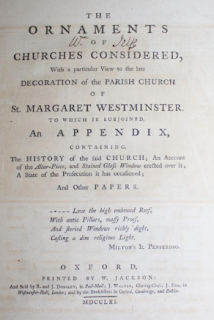'Notwithstanding all their violence': the Homilies and an 18th century Anglican defence of imagery
Wilson began by recognising the context in which the Homilies were written, a context in which reformation of the Church was necessary and robust challenge had to be made of erroneous teaching and practices:
the Compilers of the Homilies proceeded like Philosophers, who knew that when the Minds of Men were warped, it was necessary even to bend them into a contrary Direction.
This, of course, echoed how Article 35 described the Homilies as "necessary for these times", wisely discerning that the Homilies were limited by their particular context in a manner rather more extensive that was the case with Prayer Book and Articles. Wilson, therefore, went on to state the corollary of this:
But the Time is come when the Restraint may be taken off without any Apprehension of their returning to their former Situation, or their even palling that Medium in which Truth is placed.
This was reflecting the view of the most influential 18th century commentator on the Articles, Burnet:
Bishop Burnet was clearly of this Opinion, for he says on the Thirty-fifth Article of the Church of England which relates to the Homilies, that, if the Nation should come to be quite out of the Danger of falling into Popery, it would not be so necessary to insist upon many of the Subjects of the Homilies, as it was when they were first prepared.
In addition to this, Wilson also noted that the Homily against Peril of Idolatry itself included a statement which indicated that its concern for the removal of imagery was in a context in which idolatry was likely, rather than any view that images "were simply forbidden by the New Testament":
Indeed the Compilers seem to have insinuated this themselves; for notwithstanding all their Violence, the third Homily begins thus, “Now ye have heard how plainly, how vehemently, and that in many Places, the Word of God speaketh against not only Idolatry and worshipping Images, but also against Idols and Images themselves: (I mean always thus herein, in that we be stirred and provoked to worship them, and not as though they were simply forbidden by the New Testament, without such Occasion and Danger.)”
This careful qualification within the Homily itself was, as Gerald Bray states, the result of a "starkly moderating" revision by Elizabeth I herself, "to ameliorate the biting rhetoric of her homilist".
Wilson's approach to the Homily against Peril of Idolatry, therefore, was based upon Elizabeth's qualification within the text itself, a recognition of the particular context which the Homilies addressed (the cult of images in late medieval Latin piety), and the interpretation set forth by Burnet in which the implications of the careful wording of Article 35 were expounded.
Another example of this approach is seen in how the Homilies strictures against prayer for the departed were understood to be similarly addressing the particular context of late medieval Latin piety and not, therefore, as possessing a continued authority to shape Anglican liturgical practice. Old High Churchman William Palmer, in his 1832 Origines Liturgicæ - making the case for the patristic origins of the Book of Common Prayer - addressed why the 1552/59 Eucharistic rite omitted commemoration of the faithful departed in the Church's prayer, prior to its restoration in 1662:
The satisfactory and sufficient reason, therefore, for the omission of such prayers in the English liturgy is, that they were inexpedient. Considering the circumstances of the times, more evil than good would have been the result of the continuance of this practice. It was therefore relinquished, and the happy consequence was, that all the people gradually became free from the error of purgatory ... And when the doctrine of purgatory had been extirpated, the English church restored the commemoration of saints departed in the liturgy, which had been omitted for many years from the same caution and pious regard to the souls of her children.
Placed alongside Wilson on the Homilies and imagery, this points to how pre-1833 Anglicanism had a method of interpreting the Homilies which, while thankful for their role in the necessary reformation of the Church, did not regard them as possessing an enduring authority. This, therefore, provided space for Anglicans to recover - in Reformed Catholic fashion - practices which were inappropriate in the Reformation era but which could have a legitimate place in later Anglicanism, pruned of erroneous connotations. Here, in other words, is another source for a certain counterfactual.




Comments
Post a Comment